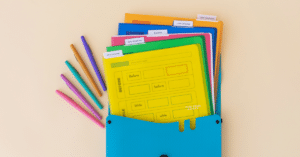Listen on Apple Podcasts Listen on Spotify
This Week’s Episode: Assessing Language: Making Recommendations
It has been such a blast having Kallie Knight join me on the podcast. First, we covered Getting Started with Language Assessments, and followed that with Formal Assessments for Language Referrals. and last week we covered different options for informal assessments.
Today Kallie and will be wrapping up this discussion by tying it all together with how to make recommendations when it comes to language assessments.
Let’s get to it!
You’ve got all this data… now what?
Step 1: 3 Questions to ask
𝟏 Is there a disability?
𝟐 Is there an adverse educational or social impact?
𝟑 Do they actually require specially designed instruction from a speech-language pathologist?
Step 2: Compare your data
✓ Does the formal evaluation score qualify the student for special education?
✓ Do your informal results (language sample, parent-teacher communication) support your formal evaluation? Does it refute those things?
✓ Write your recommendations based off of those three questions. It allows you to look at all your data.
Answering those three questions will help you determine eligibility.
✨ Need the SLP Now Paperwork Binder to help streamline your process? SLP Now members can grab it here!
(Not a member? Sign up for a free trial and search for “paperwork binder” once you’re in!)
Here’s what to expect this month:
October 4: Getting Started
October 11: Formal Language Assessment
October 18: Informal Language Assessment
October 25: Making Recommendations
Subscribe & Review on iTunes
Are you subscribed to the podcast? If you’re not, subscribe today to get the latest episodes sent directly to you! Click here to make your listening experience auto-magic and as easy as possible.
Bonus points if you leave us a review over on iTunes → Those reviews help other SLPs find the podcast, and I love reading your feedback! Just click here to review, select “Ratings and Reviews,” “Write a Review,” and let me know what your favorite part of the podcast is.
Thanks so much!
Transcript
Marisha: Hello there, and welcome to the SLP Now Podcast, where we share practical therapy tips and ideas for busy speech language pathologists. Grab your favorite beverage and sit back as we dive into this week's episode.
Marisha: Welcome to the SLP Now Podcast. This is our last episode of the month in the series all about language assessment with Kallie Knight and today we are wrapping up all the things and talking about making recommendations. If you weren't here for the previous episodes, consider heading back to the previous episode. We started the series in episode 138 and we talked about how to get started with an evaluation. Then we dove into formal assessments in episode 139, and then in 140 we talked about informal assessments, and now we're going to tie it all together.
Marisha: Kallie, what recommendations do you have? Maybe we got some formal assessments done. Let's say we did the TILLS and we have parent-teacher input, work samples, language sample. We did a present level standard waste assessment. We did some dynamic assessment. Like how in the world do we start tying this together and making sense of it?
Kallie: So again, I'm talking in the context of school-based SLP so again, this is another zoom out. These podcasts are good because we're reminding people to zoom out and remember the bigger picture, but eligibility at least in a school for most places and states is three prongs. So we have to have a disability. There has to be a significant and adverse impact on education, which could be like maybe they're not meeting those standards, and it has to be because of that disability that you've identified. And on top of that, they have to require specially designed instruction. And so I think remembering that they need to meet these three prongs, I'm looking at my data to see how am I answering those three questions. Is there a disability? Is there an adverse educational or social impact? And do they actually require specially design instruction from a speech language pathologist?
Kallie: So just remember those questions. So as I'm looking through all my data, I might pull my formal test and say my formal evaluation says they got a standard score of 75. And most districts it's probably going to be a score that would qualify a student for special education on the basis of say that formal evaluation only. So that might fall into that, "Do they have a disability?" part that might say there's some evidence for a yes. But then I would look at my own formal evaluations and all that data and I would say, "Okay, do my data and my informal, so those language samples, those parent-teacher information, like everything we've talked about up to this point, does that support what I just got or those results that I just got in my formal evaluation? Or does it maybe refute those things?" And a lot of times this, at least for me, like I said, I worked in Title 1 schools and in very diverse schools where sometimes the informal information I get shows that perhaps it was an experiential, or a lack of experience, or it was language or content bias, something like that.
Kallie: So in some cases, your informal information may refute the results that you got in your formal evaluation and then of course, you'd write your recommendations and evaluation that way. Or a lot of times it just confirms that, yep, not only do they have a disability, but in my informal that's where I find the quality of the disability. So I'm seeing what was the functional impact, what are the skills that are making them not be able to do A-B-C-D-E skills? And that part I feel like often is answering those B and C prongs of, is there a significant adverse educational impact and does it require specially designed instruction? I really also think for the third prong, does it require specially designed instruction, looking back at my information, especially dynamic assessment, to see what supports do they need to be successful? Does it require specially designed instruction?
Kallie: Or maybe this kid just needs a 504 plan and they need certain accommodations that are going to support them, but they don't need to be pulled out of class. That wouldn't be least restrictive for them. So I'm just going through different things that you might be thinking, but based on that three pronged. I think when you're looking to answer those three questions and you look at all your data, it just makes it easier than, "I don't have anywhere to hang all my coats" kind of thing. That was a lot of information that I just like fire hosed, but...
Marisha: No, that was awesome. Okay, we're getting into the nitty gritty with all of these different options, but let's zoom out at the big picture. So we've got the big picture. Can we go into some specific examples or scenarios of what that could look like? What would you see in an informal assessment? Let's say the student got standard score of 75 on whichever assessment you choose. What would you see in the informal assessment that would refute that?
Kallie: So this often happens in the cases, like I said, of anyone who may be falling under culturally linguistically diverse, but it doesn't have to be because experiential factors can come from anyone. Let's say that we gave this self or something or we were doing a vocabulary test and they scored fairly poorly. And then I did something informal, whether it's dynamic assessment, so kind of like that test teach retest model. And then I realized, "Oh, if I give a minimum or just a certain amount of instruction or a certain support, oh they got it." It was like a light bulb where maybe sometimes the kids even say, "Well I've never heard that word before." And so things like that are things that I note and say, "Okay, this is likely experience because when I gave a little bit of instruction, for example, they got it real quick."
Kallie: So if a teacher did that and they knew now maybe this child just didn't ever hear A-B-C-D-E. If they're just given the instruction and it's not assumed that the kid just knows it, then maybe it would be fine. And then you can say that likely affected whatever subtest in formal. I would never say it did because you never know if it did affect it or not. But you can say it is likely based on whatever your data that that is what negatively impacted this score.
Kallie: And in that kind of case then it would refute your formal findings as opposed to, I'll use the same example, you did dynamic assessment or you did a language sample and you saw that they consistently made, let's see, I'm going to use the self for example. So say they did really poorly on formulating sentences or a certain syntactic structures, that is your sample of "n equals one" of a certain syntactic structure. So if I look in a language sample and they consistently are still either omitting, not using, or using it incorrectly, then that's data to say, "Yep, that was likely." As opposed to sometimes they just make a mistake the one time, not one item on the self, but every other time maybe in a language sample they're fine. It was just a fluke. So that's kind of maybe how it would be different and how you could use either dynamic assessment or language sample to parse that out.
Marisha: What about the accommodations idea? So can we use the self following directions subtest? So if a student scores poorly there, what would you see in your informal assessment that might lead you to recommend a 504 instead?
Kallie: So this is a good example of, I think in a previous episode, I think I said I was going to talk about this informal and then didn't. But if I'm going to have to use a formal thing like following directions, what I'll do is, of course I'll give it as is because it's standardized. But then what I might do is say, "Let's see what happens if I give them one single repetition, I'm just going to repeat the instructions one time and if they get it after a single repetition, I might put plus R." And so that's my informal data that says with a single repetition, they got it right. Or sometimes it's a vocabulary issue, maybe it's the core word in the instruction that they've just never heard before or they're just not familiar with it. And so I define a core vocabulary word and then I did it again and they got it immediately.
Kallie: And then maybe I do it a couple other times just to make sure it wasn't a fluke there too. But I do that many times. So for me, if you look at the self and the following directions, you'll see in my margins that I have that R plus-minus. So minus would be I gave them a repetition and it didn't work. Sometimes I give up to two repetitions because sometimes a second repetition is all they need. But there's some that you could give three or four repetitions and it's not going to get any better. And so when I'm reporting it in my evaluation, I say, "When X amount of test items were incorrect in those test items, I gave one repetition and one given one repetition, they got maybe 85% of those correct indicating that it is likely that a single repetition is helpful for this student."
Kallie: And I wouldn't do it with only that substest. I do that with other subtests as well so you can see that across different skills. Having a single repetition significantly helps this kid, so it's likely that maybe an accommodation or really sometimes I don't even think you need an accommodation. So many kids benefit from a single repetition. Sometimes going back and just saying they don't qualify and they really don't need anything. Just keep in mind that you might want to repeat things not only for this kid, but for everyone. So that's maybe an example of how I would maximize the use of my formal evaluation.
Marisha: Yeah, and it's hard to give examples because we are so general and of course don't take this and be like, "Well Kallie said this student doesn't qualify because the single repetition on the following directions subtest." But I think these are really helpful examples and things to consider and we use our clinical judgment, but given all the data, does a student need specially designed instruction if their performance increases significantly if they're given a single repetition? Only you can decide that when given all of the information, but I love this as an example.
Kallie: And I will say again, this is also me coming from me working with a demographic that often is a second language learner. So if you have these kids that are coming to you and you're like, "Ooh, should they not qualify, but what should I recommend to support them?" There are a lot of accommodations that you don't need through a 504, but that they get because they're in ESL or like an ESL program. And so you can always recommend, for example, a lot of them could be a simple repetition or clarification or definition of unfamiliar vocabulary. Those are actually accommodations that aren't even written out but that they receive as learners or ESL. They also just changed the acronym, but as they're learning English as a second language. But you formally putting that in writing and saying, "I tested him and he did benefit from this." I think that's good for everyone working with that student to know that they're not just doing it just because, but when they do it with intentionality, then they can really help the kid. And that could be for not an English language learner, but that's just an example that's common in the demographic I work with.
Marisha: Yeah, super helpful and I love that you were able to take the more general examples and make them a little bit more specific. Hopefully that was a helpful explanation for everyone listening. Is there anything else that you would share in terms of making those recommendations and pulling everything together?
Kallie: Without going off and doing another podcast worth of rambling? No, probably not. I think again, zoom out, especially if you're a school-based SLP, look at those three prongs of disability, and look at all your data and see how they answer those three questions and that's going to help you determine eligibility. And then hopefully you did good informal to subsequently decide what you're going to work on goals wise.
Marisha: Awesome. And then we will be doing a series on goal writing and stuff. I think it'll be next year so something to stay tuned for if you're like wondering how in the world do I go from there? I know that's a horrible teaser, but I'll see if I can put any other resources in the show notes in the meantime. But yeah, stay tuned for that. Thank you so much for so generously sharing your time Kallie. This was super helpful. I'm really glad we got to talk about this mega topic. I really just wanted to share some tips and kind of building that general framework because this could easily be a week long seminar of stuff. So props to you for distilling it into one hour.
Kallie: Girl, we tag teamed it and kind of like you said, I hope it's helpful, but don't take every single thing at face value because consider, that's my favorite word and I'm glad that you used it. Consider this information. If it doesn't apply to your kid, it doesn't apply to your setting, it doesn't apply to whatever, that's okay. Take the nuggets that do apply and just make it work for you.
Marisha: Okay, well that is a wrap and we'll see you next time.
Marisha: Thanks for listening to the SLP NOW Podcast. If you enjoyed this episode, please share with your SLP friends and don't forget to subscribe to the podcast to get the latest episodes sent directly to you. See you next time.
Sign up to receive email updates
Enter your name and email address below and I'll send you periodic updates about the podcast.




Reader Interactions